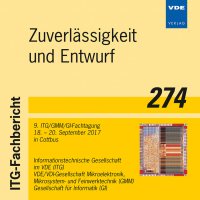Low ppm failure analysis for advanced Cu and Cu alloy on-chip wiring
Konferenz: Zuverlässigkeit und Entwurf - 9. ITG/GMM/GI-Fachtagung
18.09.2017 - 20.09.2017 in Cottbus, Deutschland
Tagungsband: Zuverlässigkeit und Entwurf
Seiten: 7Sprache: EnglischTyp: PDF
Persönliche VDE-Mitglieder erhalten auf diesen Artikel 10% Rabatt
Autoren:
Kraatz, Matthias (Fraunhofer Institute for Ceramic Technologies and Systems IKTS, Dresden, Germany)
Hauschildt, Meike (GLOBALFOUNDRIES Dresden Module One LLC & Co. KG, Dresden, Germany)
Gall, Martin; Zschech, Ehrenfried (Fraunhofer IKTS, Dresden, Germany)
Inhalt:
Electromigration early failure void nucleation and growth phenomena were studied using large-scale, statistical analysis methods. A total of about 496,000 interconnects were tested over a wide current density and temperature range (j = 3.4 to 41.2 mA/μm2, T = 200 to 350 °C) to analyze the detailed behavior of the current density exponent n and the activation energy Ea. The results for the critical V1M1 downstream interface indicate a reduction from n = 1.55 ± 0.10 to n = 1.15 ± 0.15 when lowering the temperature towards 200 °C for Cu-based interconnects. This suggests that the electromigration downstream early failure mechanism is shifting from a mix of nucleation-controlled (n = 2) and growth-controlled (n = 1) to a fully growth-controlled mode, assisted by the increased thermal stress at lower temperatures (especially at use conditions). For Cu(Mn)-based interconnects, a drop from n = 2.00 ± 0.07 to n = 1.64 ± 0.2 was found, indicating additional effects of a superimposed incubation time. Furthermore, at lower current densities, the Ea value seems to drop for both Cu and Cu(Mn) interconnects by a slight, but significant amount of 0.1 – 0.2 eV. Implications for extrapolations of accelerated test data to use conditions are discussed.


